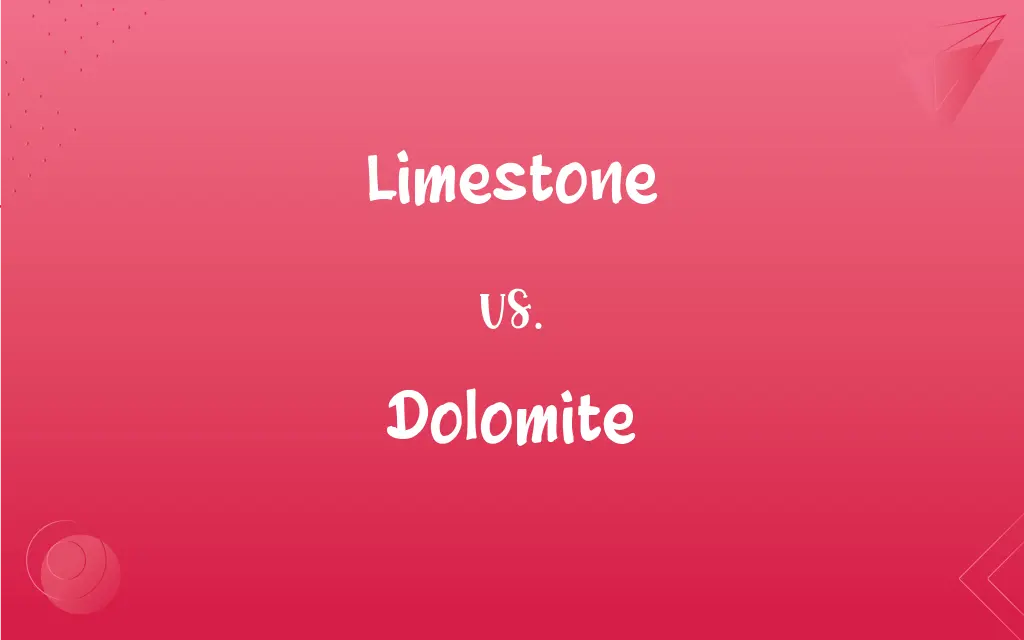Limestone vs. Dolomite: What's the Difference?
Edited by Aimie Carlson || By Janet White || Published on January 1, 2024
Limestone is a sedimentary rock primarily made of calcium carbonate, while dolomite is a mineral rock containing calcium magnesium carbonate.

Key Differences
Limestone is primarily formed from the skeletal fragments of marine organisms such as coral and mollusks, consisting mainly of calcium carbonate (CaCO3). Dolomite, however, is a mineral rock that also contains calcium carbonate, but with a significant amount of magnesium (CaMg(CO3)2).
Limestone typically displays a granular texture and comes in a range of colors from white to gray. Dolomite is often distinguished by its pinkish hue, though it can also be white or gray, and has a smoother, crystalline texture.
The presence of magnesium in dolomite gives it slightly different chemical properties compared to limestone. Limestone reacts vigorously with acids, producing carbon dioxide, while dolomite's reaction is slower due to the magnesium content.
Limestone is widely used in construction, for making cement, and as a neutralizing agent in agriculture. Dolomite, while also used in construction and agriculture, is particularly valued for its magnesia content, important in the production of refractory materials.
Limestone is more common and can be found in sedimentary rock layers worldwide. Dolomite is less common and often forms as a result of the alteration of limestone under particular geological conditions.
ADVERTISEMENT
Comparison Chart
Primary Composition
Calcium Carbonate (CaCO3)
Calcium Magnesium Carbonate (CaMg(CO3)2)
Texture and Color
Granular, White to Gray
Smooth, Crystalline, White to Pinkish
Reaction with Acids
Vigorous, producing CO2
Slower due to magnesium
Main Uses
Construction, Cement, Agriculture
Construction, Refractory materials, Agriculture
Geological Occurrence
More common, in sedimentary rock layers
Less common, often from altered limestone
ADVERTISEMENT
Limestone and Dolomite Definitions
Limestone
Limestone is reactive to acid, making it useful in testing for acid rain.
Geologists used limestone to detect the presence of acid in rainwater.
Dolomite
It forms as a result of limestone alteration through magnesium-rich fluids.
Geologists discovered dolomite formations near ancient seabeds.
Limestone
Limestone is often formed from shell fragments and marine organism remains.
Fossils found in limestone offer valuable insights into Earth's history.
Dolomite
Dolomite has a distinctive pinkish hue and crystalline structure.
The pinkish color of the rock indicated it was dolomite.
Limestone
A sedimentary rock mainly composed of calcium carbonate.
The White Cliffs of Dover are a stunning example of limestone formations.
Dolomite
In construction, dolomite is valued for its durability and hardness.
The architect chose dolomite for the building's exterior for its resilience.
Limestone
It's widely used in construction and as a raw material in cement production.
The limestone quarry supplied materials for the city's new buildings.
Dolomite
Dolomite is used in the production of refractory materials due to its high magnesium content.
The steel industry relies on dolomite for manufacturing heat-resistant linings.
Limestone
In agriculture, limestone is used to neutralize acidic soils.
Farmers spread limestone to improve soil pH for better crop yields.
Dolomite
Dolomite is a mineral rock containing calcium magnesium carbonate.
The mountain range was composed mainly of impressive dolomite rocks.
Limestone
A common sedimentary rock consisting mostly of calcium carbonate, CaCO3, used as a building stone and in the manufacture of lime, carbon dioxide, and cement.
Dolomite
A white or light-colored mineral, essentially CaMg(CO3)2, used in fertilizer, as a furnace refractory, and as a construction and ceramic material.
Limestone
An abundant rock of marine and fresh-water sediments; primarily composed of calcite (CaCO3); it occurs in a variety of forms, both crystalline and amorphous.
Dolomite
A magnesia-rich sedimentary rock resembling limestone.
Limestone
Pertaining to or made of limestone.
Dolomite
(mineral) An evaporite consisting of a mixed calcium and magnesium carbonate, with the chemical formula CaMg(CO3)2; it also exists as the rock dolostone.
Limestone
A rock consisting chiefly of calcium carbonate or carbonate of lime. It sometimes contains also magnesium carbonate, and is then called magnesian or dolomitic limestone. Crystalline limestone is called marble.
Dolomite
A mineral consisting of the carbonate of lime and magnesia in varying proportions. It occurs in distinct crystals, and in extensive beds as a compact limestone, often crystalline granular, either white or clouded. It includes much of the common white marble. Also called bitter spar.
Limestone
A sedimentary rock consisting mainly of calcium that was deposited by the remains of marine animals
Dolomite
A kind of sedimentary rock resembling limestone but consisting almost entirely of the mineral dolomite
Dolomite
A light colored mineral consisting of calcium magnesium carbonate; a source of magnesium; used as a ceramic and as fertilizer
FAQs
What is dolomite?
Dolomite is a mineral rock containing calcium magnesium carbonate.
How is limestone formed?
Limestone is formed from the skeletal fragments of marine organisms.
How is dolomite formed?
Dolomite forms from limestone altered by magnesium-rich fluids.
Can limestone be used in agriculture?
Yes, it is used to neutralize acidic soils.
Does dolomite react with acid?
Yes, but the reaction is slower than limestone due to its magnesium content.
Can limestone be used as a building material?
Yes, it's a common material in construction.
What are the main uses of limestone?
Limestone is used in construction, cement production, and soil neutralization.
Is limestone reactive to acid?
Yes, limestone reacts vigorously with acids.
What is the color of dolomite?
Typically white to pinkish.
What is limestone?
Limestone is a sedimentary rock primarily made of calcium carbonate.
What is the color of limestone?
It varies from white to gray.
What are the main uses of dolomite?
Dolomite is used in construction, refractory materials, and agriculture.
Is dolomite used in the steel industry?
Yes, particularly for making refractory linings.
Is limestone harder than dolomite?
No, dolomite is generally harder due to its magnesium content.
Where is limestone found?
It's found in sedimentary rock layers worldwide.
Can limestone be used for water purification?
Yes, it's used in water treatment processes.
Does dolomite contain fossils?
Rarely, as it forms from altered limestone.
Where is dolomite found?
It's less common and often found near altered limestone areas.
Is dolomite good for construction?
Yes, it's valued for its durability.
Are there fossils in limestone?
Yes, it often contains fossil remnants.
About Author
Written by
Janet WhiteJanet White has been an esteemed writer and blogger for Difference Wiki. Holding a Master's degree in Science and Medical Journalism from the prestigious Boston University, she has consistently demonstrated her expertise and passion for her field. When she's not immersed in her work, Janet relishes her time exercising, delving into a good book, and cherishing moments with friends and family.
Edited by
Aimie CarlsonAimie Carlson, holding a master's degree in English literature, is a fervent English language enthusiast. She lends her writing talents to Difference Wiki, a prominent website that specializes in comparisons, offering readers insightful analyses that both captivate and inform.

































































